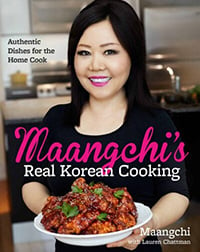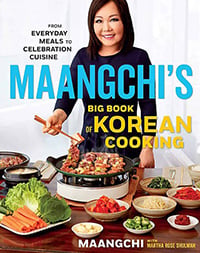Today I’m going to introduce you to my recipe for gomtang, a traditional Korean soup that is perfect for this cold season. Gomtang is a hearty soup made with long-simmered beef and intestines. It can also be made with pork, goat, or chicken, but beef gomtang is the most common and popular.
When I lived in Korea, I used to go to a famous gomtang restaurant with my family. The soup was delicious and worth the drive! Here in New York, I can’t find any good gomtang restaurants at all. The taste is always different from what I ate in Korea. This recipe I’m showing you today is based on the gomtang that I remember.
You may be wondering what the difference is between seolleongtang and gomtang. I shared a seolleongtang recipe years ago, but now I think it needs a simpler and easier update. Stay tuned! But generally gomtang is a clear soup made by boiling beef and intestines. Seolleongtang is a soup made by boiling beef bones for a long time and then boiling beef with the bones. The cooking time of seolleongtang is much longer, and the soup is known by its milky-white broth. Depending on the amount of bones, it can take more than a day or 2 days of boiling! Gomtang has no bones so it usually needs just two to three hours of boiling, until the beef becomes tender.
When serving gomtang, Koreans do it using the toryeom method. That is, we use the super-hot boiling broth to warm up the prepared ingredients (rice, beef, and tendon) before we fill the bowl with the final broth and serve. Using toryeom method makes the ingredients hot and soft, and the final bowl of gomtang even more delicious.
Gomtang is almost always served with well-fermented, crunchy and spicy kkakdugi, but you can use well-fermented kimchi as well. Enjoy it!
Ingredients
Makes 4 servings
- 2 pounds beef brisket
- 2 pounds beef tendon
- 8 ounces Korean radish (or daikon), cut into chunks
- 2 dae-pa (large green onions), one chopped, the other sliced 2 inches long
- 1 medium-size onion, quartered
- 12 garlic cloves
- 2 ounces dangmyeon (sweet potato noodles, or glass noodles), soaked in cold water for 40 minutes
- 1 tablespoon fish sauce
- 1 tablespoon plus 1 teaspoon kosher salt
- ground black pepper and hot pepper flakes to taste
- cooked rice
- gochu-garu (Korean hot pepper flakes) to taste (optional)
- fermented kkakdugi (cubed radish kimchi) for a side dish

For egg strips (gyeran-jidan)
- 2 eggs
- ¼ teaspoon kosher salt
- 1 teaspoon cooking oil (or grape-seed oil, vegetable oil, etc)
Directions
Prepare beef, tendons, and broth
- Trim the fat from the beef and beef tendon, then wash them in cold running water.
- Soak them in cold water for 1 hour to overnight, changing the water a couple of times to remove blood. Drain.


- Bring a large pot of water to a boil and add the beef and tendon. Stir with a wooden spoon and cook for 10 to 15 minutes with the lid open, until fatty brownish foams come up on the surface.

- Remove from heat and drain. Rinse the beef and tendon in cold water. Wash the large pot with soapy water.

- Add the beef, tendon, radish, onion, 1 large green onion (cut into 2 inches long), and garlic to the cleaned pot. Add 6 quarts of water (24 cups), cover and cook over medium-high heat for 30 to 35 minutes until boiling.

- Reduce the heat to medium and cook for 2½ hours until the beef and tendon are soft. Taste to check tenderness. If not tender enough, cook a little longer.

- Remove from heat and let the beef and tendon cool. Strain the broth, yielding about 14 cups. If less, add water to make it 14 cups. Discard the mushy cooked vegetables.
- Let the broth cool, then refrigerate until the fat on the surface solidifies. Remove and discard the solid fat.

- Slice the beef and tendon into bite-size pieces and set aside.


Make gyeran-jidan (egg strips)
- Beat the eggs with salt. Strain them into a small bowl and discard any stringy bits remaining in the strainer.

- Heat a large nonstick skillet over medium-high heat. Add oil and swirl to coat. Wipe off excess oil with a paper towel, leaving a thin layer.
- Turn off the heat and pour the egg mixture into the skillet. Shape it to a large circle shape by tilting the skillet this way and that. Cook for a couple of minutes until set.
- Turn it over and let both sides set with the remaining heat. If it’s not set, you can cook it for another minute over low heat.

- Transfer to a cutting board and slice into thin strips. It can be used immediately or stored in an airtight container in the refrigerator for up to 3 days.
Put gomtang together and serve
- Drain the noodles and cut them into approximately 2-inch lengths. Add them to the broth.

- Stir in fish sauce and 4 teaspoons salt (or to your taste) and bring it to a boil.
- Place a bowl of rice into a ttukbaegi (Korean earthenware bowl) or a large bowl and add some tendon and beef.
- To warm up the rice, beef, and tendon, try the Korean “toryeom” method. Crank up the heat first! Then, ladle some hot broth into the bowl. Use the ladle to hold everything in place while pouring the broth back into the pot. Repeat a couple times until everything is warm and ready. Finally, add your final ladles of broth to serve.

- Sprinkle ground black pepper, chopped green onion, egg strips, and gochu-garu (if used) over top.
- Repeat these steps for each serving, adding rice, beef, tendon, to each additional bowls. Keep the broth boiling as you work.
- Serve immediately with fermented radish kimchi and any additional side dishes you want.


Maangchi's Amazon picks for this recipe
It's always best to buy Korean items at your local Korean grocery store, but I know that's not always possible so I chose these products on Amazon that are good quality. See more about how these items were chosen.









![[OTTOGI] Delicious COOKED RICE...](https://m.media-amazon.com/images/I/41zYdZ3EWJL._SL160_.jpg)






















Friday, my husband bought three calves feet already cut into slices.
I soaked them in ice-cold water, removed the marrow (for small dumplings) and cut off the skin (maybe I’ll fill those rings with ground meat) – now I have enough tendons to make this dish tomorrow and bones for seolleongtang later!
I’m happy!
Yes, I can feel your passion for cooking delicious food! : )
Dear Maangchi,
A few years ago, I tried to handle calves’ feet – it was a disaster.
Not for our friends’ dogs; they loved the result (especially frozen – Doggie ice-cream! ;-))
This time – soaking and blanching worked wonders. Not ready yet, but already tasting wonderful!
My husband will have to be at the dentist several times, therefore hearty soups are the meals of choice. And gorigomtang at a special place (not for tourists) was our favorite next to hoe every time when we were in Busan at Songdo Beach. Your recipes hit the spot!
❤️
So good! Wow!
Absolutely worth the effort!